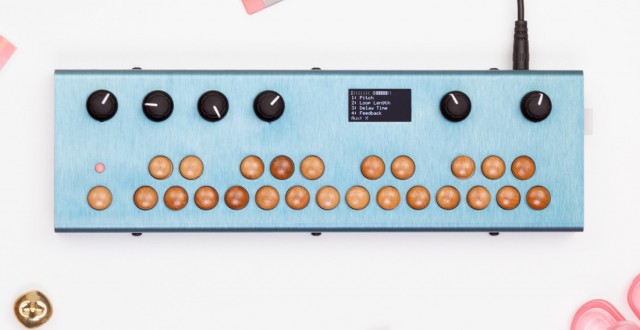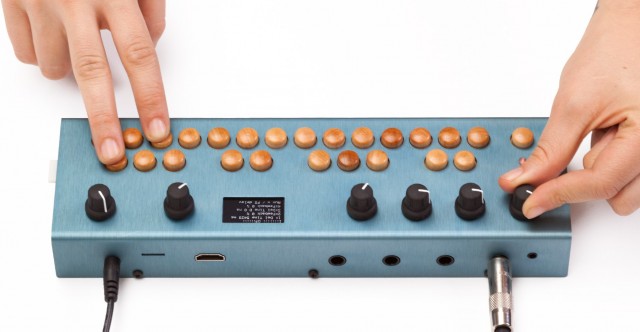
Critter & Guitari co-founder Chris Kucinski let us know that they have introduced a new ‘flagship’ instrument, the Organelle.
The Organelle offers a similar interface to some of their other instruments, but the instrument features a powerful sound engine that runs Pure Data patches.
Pure Data (aka Pd) is an open source visual programming language, designed to allow musicians, visual artists, performers, researchers, and developers to create software graphically, without writing lines of code.
Patches allow the instrument to take on different forms. Onboard hardware for sound input and output and mappable knobs, keys and buttons enable patches to synthesize, sample, effect and anything in between.
Expandable
The Organelle ships with a set of common default patches, and new patches may be loaded from a USB drive. Select patches from a community-driven online repository, transfer them to a USB drive, reinsert it in the Organelle and play!
Patches may be created and/or edited directly on the device as well as on a personal computer. Plug in a keyboard, mouse and monitor and begin customizing. The Organelle runs patches created in Pure Data. You can write patches in lower level languages too.

Features:
- Audio:
- 1x ¼” Stereo Sound Input Jack
- 2x ¼” Mono Sound Output Jacks (L and R channels)
- 1/8″ Stereo Headphone output Jack
- ¼” Footswitch Jack
- Interface:
- OLED Display Screen
- Four Parameter Knobs, Rotary Selection knob with push button select
- Volume Knob
- 25 Maple Keys
- 1x RGB LED
- Processor: 1GHz ARM Cortex A9
- Operating System: Linux
- Additional Connections:
- HDMI output port
- 2x USB port (MIDI over USB, Serial over USB)
- Power: 9VDC, 1.0 Amp (Power Supply included)
- Physical Characteristics
- Size: 10.5″ x 3.25″ x 2.125″
- Enclosure: Anodized Aluminum Top, ABS Bottom with Rubber Foot Pads
Kucinski expects the Organelle to be available in later 2015. Video and sound demos are coming ‘soon’. Pricing is to be determined.

Want!
It is really hard to find anything to not like about this. There’s a tiny little screen, but also an HDMI port! I think that’s ideal, you can use the little screen when you’re out and about, and plug in a monitor when you’re ready to edit your PD patches.
I expect this will also be a very fine effect unit as well.
I don’t know anything about what is available in the PD world. Does seem like a widely liked platform.
What are the specs (sample-rate, resolution) of the audio I/O ?
– audio over USB ??
Would be nice to have an expression pedal input too.
– and maybe a few more analog inputs (not audio) for other sensors.
What ever happened to CSound?
– – will it be able to accept and react/respond to MIDI CC data (Continuous Controller) ?
* the little ‘edit’ widget for this comment section is a pain to use!!!!!!!
I love PD and grew up with it
I love the shbobo shnth
this will be so perfect for me
thank you
I would love to see expression pedal input as well
Uh-oh, I see the word ‘flagship’ and that tells me +$$. On the other hand, you know I’m going to pay whatever.
Looks like they’ve put a Raspberry Pi in one of their little boxes.
I’ve been working on the exact same thing. Kinda mad they beat me too it, but also kinda really want this!!
No midi I/O. Gah.
Oh wait… Midi over usb.. Gah.
This is so close but doesn’t quite hit the mark for me.
Look it’s a USB host jack not a device jack. What does that tell you? USB to Din I/O adapter possible.
HDMI port must be a rasperry pi…
@Jordan I asked about this to C+G they said you can use a USB to midi cable …implying that it can actually HOST USB devices…I really hope this stands to be true
Yeah, this looks quite interesting. Wonder if it will be Teenage Engineering expensive though. Also the lack of DIN MIDI is a bummer. This could be the missing unique sound source in my live rig but I don’t want to fuss around with multiple formats for shuttling MIDI around.
Kenton usb>midi box would sort that out, no?
Or you could just run PD on the computer you already own, using the MIDI controller keyboard you already own. Total cost: zero.
I saw this instrument at the Machines in Music synth show in NYC this weekend. The C&G guy did a little demo and it looked pretty cool. They had a full on PD session on the connected display with mouse and keyboard. This thing is a small ARM based Linux machine. Initially I thought it was an RPi as well, but the guy said that it’s a custom system on a chip design — most likely somewhat similar.
While yes, as some here argue, you could essentially do the same thing from your current computer, I thought it it was a pretty elegant little set-up and stood out from a lot of the other gear at the show.
What bothers me a lot is PD here more than 20 years, and i never hear proper music made straight in it. If you search on soundcloud for PD, you’l hear dozens of blip and blops, but not a music most of the time. Libpd here for 5 years or so, MobMuPlat (love it) here for couple of years or so, and it does not have proper music community. PD on raspberry pi here for 3 or more years, and i don’t see any cool music DIY projects with it. A single cool music thing made by pure data is Elastic Drums for IOS, and it’s not an open software, and it’s very… peculiar sound.
So why C&G think if they sell us similar things with wood buttons for more money, there will be that community? If they provide some good patches (complete instruments and effects, or modular style components) developed by them for their device, it may be good point, but if it just a platform for some PD community, that community can never shows up.
“What bothers me a lot is PD here more than 20 years, and i never hear proper music made straight in it.”
I hear plenty of music made straight in it, it’s not like the electronic / performance acts put them on album covers.
“So why C&G think if they sell us similar things with wood buttons for more money, there will be that community?”
Because they are familiar with that community.
“if it just a platform for some PD community, that community can never shows up.”
Isn’t that a silly attitude. They wouldn’t be making a device with no market. You just happen to not be the market they’re appealing to.
Not true! There’s tons of utilities and softwares using pd, not to mention tons of musical things made with PD, a lot of the time people don’t even tell you that they use PD. I made a drum machine for android using Libpd. Check it out https://play.google.com/store/apps/details?id=com.zackhagan.beatbox
Looks to me like something that could be based on a Raspberry Pi with some additional IO. Hopefully the fact that it could be readily replicated by many potential users will be reflected in the price.
**EDIT**
🙂 It looks like I replied to an un-updated view of the page and didn’t see everyone elses’ Pi comments
Do it yourself : http://www.csounds.com/journal/issue18/eurorack.html
What about just buying a axoloti board, and then build this with your favorite midi controller… axoloti has a nodebased system like pd, made for audio..